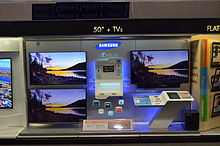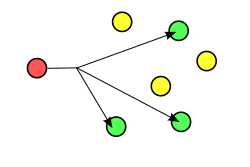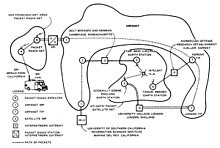LG
Smart TV model 42LW5700-TA showing web browser, with on-screen keyboard
active; unlike traditional TVs, a smart TV enables the viewer to
interact with icons or images on the screen.
A Sony Bravia Smart TV showing the home screen.
A Smart TV, also known as a connected TV (CTV), is a traditional television set with integrated Internet and interactive Web 2.0 features which allows users to stream music and videos, browse the internet, and view photos. Smart TV is a technological convergence of computers, television sets and set-top boxes. Besides the traditional functions of television sets and set-top boxes provided through traditional broadcasting media, these devices can also provide Internet TV, online interactive media, over-the-top content (OTT), as well as on-demand streaming media, and home networking access.
Smart TV should not be confused with Internet TV, IPTV or Web television.
Internet TV refers to receiving television content over the Internet
instead of traditional systems such as terrestrial, cable and satellite,
regardless how the Internet is delivered. IPTV is one of the Internet
television technology standards for use by television broadcasters. Web
television is a term used for programs created by a wide variety of
companies and individuals for broadcast on Internet TV.
In smart TVs, the operating system is preloaded or is available through the set-top box. The software applications or "apps" can be preloaded into the device, or updated or installed on demand via an app store or marketplace, in a similar manner to how the apps are integrated in modern smartphones.
The technology that enables smart TVs is also incorporated in external devices such as set-top boxes and some Blu-ray players, game consoles, digital media players, hotel television systems, smartphones, and other network-connected interactive devices that utilize television-type display outputs. These devices allow viewers to find and play videos, movies, TV shows, photos and other content from the Web, cable or satellite TV channel, or from a local storage device.
Definition
Smart TVs on display
A smart TV device is either a television set with integrated
Internet capabilities or a set-top box for television that offers more
advanced computing ability and connectivity than a contemporary basic
television set. Smart TVs may be thought of as an information appliance or the computer system from a mobile device
integrated within a television set unit, as such a smart TV often
allows the user to install and run more advanced applications or plugins/addons based on a specific platform. Smart TVs run a complete operating system or mobile operating system software providing a platform for application developers.
Smart TV platforms or middleware have a public software development kit (SDK) and/or native development kit (NDK) for apps so that third-party developers can develop applications for it, and an app store
so that the end-users can install and uninstall apps themselves. The
public SDK enables third-party companies and other interactive
application developers to “write” applications once and see them run successfully on any device
that supports the smart TV platform or middleware architecture which it
was written for, no matter who the hardware manufacturer is.
Smart TVs deliver content (such as photos, movies and music) from
other computers or network attached storage devices on a network using
either a Digital Living Network Alliance / Universal Plug and Play media server or similar service program like Windows Media Player or Network-attached storage (NAS), or via iTunes. It also provides access to Internet-based services including traditional broadcast TV channels, catch-up services, video-on-demand (VOD), electronic program guide, interactive advertising, personalisation, voting, games, social networking, and other multimedia applications. Smart TV enables access to movies, shows, video games, apps and more. Some of those apps include Netflix, Spotify, YouTube, and Amazon.
History
In the early 1980s, "intelligent" television receivers were introduced in Japan. The addition of an LSI
chip with memory and a character generator to a television receiver
enabled Japanese viewers to receive a mix of programming and information
transmitted over spare lines of the broadcast television signal. A patent was published in 1994 (and extended the following year)
for an "intelligent" television system, linked with data processing
systems, by means of a digital or analog network. Apart from being
linked to data networks, one key point is its ability to automatically
download necessary software routines, according to a user's demand, and
process their needs.
The mass acceptance of digital television in late 2000s and early
2010s greatly improved smart TVs. Major TV manufacturers have announced
production of smart TVs only, for their middle-end to high-end TVs in
2015.
Smart TVs are expected to become the dominant form of television by the
late 2010s. At the beginning of 2016, Nielsen reported that 29 percent
of those with incomes over $75,000 a year had a smart TV.
Typical features
LG Smart TV using the web browser.
Smart TV devices also provide access to user-generated content (either stored on an external hard drive or in cloud storage) and to interactive services and Internet applications, such as YouTube, many using HTTP Live Streaming (also known as HLS) adaptive streaming.
Smart TV devices facilitate the curation of traditional content by
combining information from the Internet with content from TV providers.
Services offer users a means to track and receive reminders about shows or sporting events, as well as the ability to change channels for immediate viewing. Some devices feature additional interactive organic user interface / natural user interface technologies for navigation controls and other human interaction with a Smart TV, with such as second screen companion devices, spatial gestures input like with Xbox Kinect, and even for speech recognition for natural language user interface. Smart TV develops new features to satisfy consumers and companies, such as new payment processes. LG and PaymentWall
have collaborated to allow consumers to access purchased apps, movies,
games, and more using a remote control, laptop, tablet, or smartphone.
This is intended for an easier and more convenient way for checkout.
Platforms
Smart TV technology and software is still evolving, with both proprietary and open source software frameworks already available. These can run applications (sometimes available via an 'app store' digital distribution platform), play over-the-top media services and interactive on-demand media, personalized communications, and have social networking features.
Android TV, Boxee, Firefox OS, Frog, Google TV, Horizon TV, httvLink, Inview, Kodi Entertainment Center, MeeGo, Mediaroom, OpenTV, Opera TV, Plex, Roku, RDK(Reference Development Kit), Smart TV Alliance, ToFu Media Platform, Ubuntu TV, and Yahoo! Smart TV
are framework platforms managed by individual companies. HbbTV,
provided by the Hybrid Broadcast Broadband TV association, CE-HTML, part
of Web4CE, OIPF, part of HbbTV, and Tru2way are framework platforms
managed by technology businesses. Current Smart TV platforms used by
vendors are Amazon, Apple, Google, Haier, Hisense, Hitachi, Insignia, LG, Microsoft, Netgear, Panasonic, Philips, Samsung, Sharp, Sony, TCL, TiVO, Toshiba, Sling Media, and Western Digital. Sony, Panasonic, Samsung, LG, and Roku TV are some platforms ranked under the best Smart TV platforms.
Sales
According to a report from research group NPD In-Stat, in 2012 only
about 12 million U.S. households had their Web-capable TVs connected to
the Internet, although an estimated 25 million households owned a set
with the built-in network capability. In-Stat predicted that by 2016,
100 million homes in North America and western Europe would be using
television sets blending traditional programming with internet content.
The number of households using over-the-top television services has rapidly increased over the years. In 2015, 52% of U.S. households subscribed to Netflix, Amazon Prime, or Hulu Plus; 43% of pay-TV subscribers also used Netflix, and 43% of adults used some streaming video on demand
service at least monthly. Additionally, 19% of Netflix subscribers
shared their subscription with people outside of their households. Ten
percent of adults at the time showed interest in HBO Now.
SANSUI Smart TV:https://www.sansui-corp.com/
SMART-TECH TV:https://www.smarttech-tv.com CAIXUN Smart TV:https://www.caixun-global.com
Android LED TV TV:https://androidledtv.com
Use
Social networking
Some smart TV platforms come prepackaged, or can be optionally
extended, with social networking technology capabilities. The addition
of social networking synchronization to smart TV and HTPC platforms may
provide an interaction with both on-screen content and other viewers
than is currently available to most televisions, while simultaneously
providing a much more cinematic experience of the content than is
currently available with most computers.
Advertising
Some smart TV platforms also support interactive advertising, addressable advertising with local advertising insertion and targeted advertising, and other advanced advertising features such as ad telescoping using VOD and DVR, enhanced TV for consumer call-to-action and audience measurement solutions for ad campaign effectiveness. The marketing and trading possibilities offered by Smart TVs are sometimes summarized by the term t-commerce. Taken together, this bidirectional data flow means that smart TVs can be and are used for clandestine observation of the owners.
Even in sets that are not configured off-the-shelf to do so, default
security measures are often weak and will allow hackers to easily break
into the TV.
2019 research, "Watching You Watch: The Tracking Ecosystem of Over-the-Top TV Streaming Devices", conducted at Princeton and University of Chicago,
demonstrated that a majority of streaming devices will covertly collect
and transmit personal user data, including captured screen images, to a
wide network of advertising and analytics companies, raising privacy
concerns.
Digital marketing research firm eMarketer reported a 38 percent surge—to close to $7 billion, a 10 percent television advertising market share—in advertising on connected TV like Hulu and Roku, to be underway in 2019, with market indicators that the figure would surpass $10 billion in 2021.
Security
There is evidence that a smart TV is vulnerable to attacks. Some serious security bugs have been discovered, and some successful attempts to run malicious code to get unauthorized access were documented on video. There is evidence that it is possible to gain root access to the device, install malicious software, access and modify configuration information for a remote control, remotely access and modify files on TV and attached USB drives, access camera and microphone.
There have also been concerns that hackers
may be able to remotely turn on the microphone or web-camera on a smart
TV, being able to eavesdrop on private conversations. A common loop antenna may be set for a bidirectional
transmission channel, capable of uploading data rather than only
receiving. Since 2012, security researchers discovered a similar
vulnerability present in more series of Smart Tvs, which allows hackers to get an external root access on the device.
Anticipating growing demand for an antivirus for a smart TV, some security software
companies are already working with partners in digital TV field on the
solution. At this writing it seems like there is only one antivirus for
smart TVs available: 'Neptune', a cloud-based antimalware system
developed by Ocean Blue Software in partnership with Sophos. However, antivirus company Avira has joined forces with digital TV testing company Labwise to work on software to protect against potential attacks. The privacy policy for Samsung's Smart TVs has been called Orwellian (a reference to George Orwell and the dystopian world of constant surveillance he depicted in 1984), and compared to Telescreens because of eavesdropping concerns.
Hackers have misused Smart TV's abilities such as operating
source codes for applications and its unsecured connection to the
Internet. Passwords, IP address data, and credit card information can be
accessed by hackers and even companies for advertisement. A company
caught in the act is Vizio. The confidential documents, codenamed Vault 7 and dated from 2013–2016, include details on CIA's software capabilities, such as the ability to compromise smart TVs.
Restriction of access
Internet websites can block smart TV access to content at will, or tailor the content that will be received by each platform. Google TV-enabled devices were blocked by NBC, ABC, CBS, and Hulu
from accessing their Web content since the launch of Google TV in
October 2010. Google TV devices were also blocked from accessing any
programs offered by Viacom’s subsidiaries.
Reliability
High-end Samsung Smart TVs stopped working for at least seven days after a software update.
Application providers are rarely upgrading Smart TV apps to the latest
version; for example, Netflix does not support older TV versions with
new Netflix upgrades.









